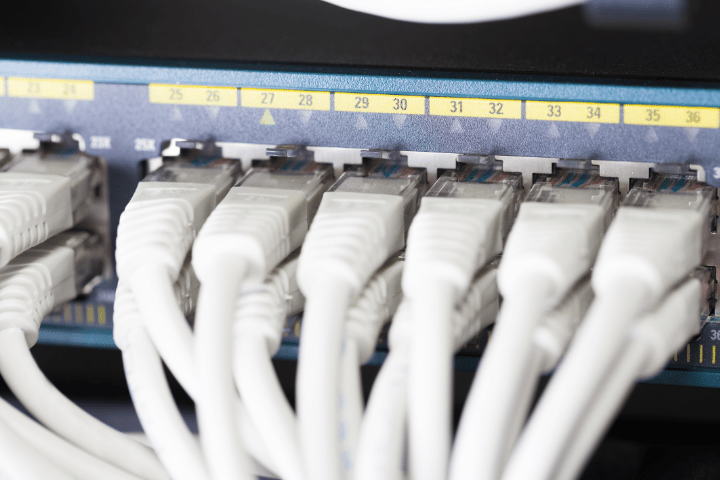Active and Passive PoE can be a great addition to your security system. But what is the difference between them?
What is PoE?
PoE means Power over Ethernet. This function transfers power and data through the same Ethernet cable. Thus, the reasoning behind using it is the lack of need for two separate cables.
Usually, there is a need to use one cable for the power supply and another for the data. But Active and Passive PoE technology removes the need for more cables.
Furthermore, cables can be bulky and stick out, but Active and Passive PoE hide in the ceiling. Therefore, it will be out of sight and out of mind.
Lastly, this will reduce the cost of maintenance or replacing the cable and increases reliability. Using PoE allows users to run cables and power cameras in locations they otherwise wouldn’t reach due to the lack of power supply.

Difference Between Active and Passive PoE
Let’s go over the main differences between Active and Passive PoE when using it in your security system.
A significant aspect of a PoE cable’s function is the delivered power. This is a safe way to transfer data and power to the camera simultaneously.
Not only will the voltage range provided be a safe amount, but it will also open the door for communication between your cameras and recorders. This power supply of power through the PoE cables will test the connection using procedure 802.3at.
If everything is set up properly and runs smoothly, the device will indicate a power supply between the sending and receiving ends of the PoE. To indicate, the devices will do a “handshake,” however, if there is a compatibility issue, the power will not be supplied.
Passive PoE
This describes the power supply that uses raw power and sends it through the ethernet cable to the connected device. The power sent through Passive PoE is unnegotiated; thus, the unit it sends power to will receive it without compatibility verification.
Without a verifying procedure, the receiving unit will continue to be pumped with power. Passive PoE is known for always staying on, regardless of compatibility between both devices.
Active PoE
On the other end of the spectrum, Active PoE sends power to devices that comply with 802.3af or 802.3at. The reason why is because, unlike the Passive PoE, it needs some sort of verification that the two devices are connected.
PoE Voltage
As we mentioned before, the Passive PoE does not need verification that the device is compatible. Thus, it would help if you were extra careful with your device’s voltage so as not to fry it up.
Too much voltage can hurt your device, such as a camera, and too little can keep it from working correctly. You should check this prior to connecting and powering your device through the PoE cables.
There are a total of three common IEEE 802.3 that are used for security cameras, including PTZ. Let’s go over the three:
- 802.3af: 15.4 W of power
- 802.3at: 30 W of power
- 802.3bt: Between 60-90 W of power
Reduction of risk
I doubt you want to fry your device’s motherboard and keep it from working. So to safely install Passive PoE, you should keep a few risk reductions in mind.
First, start off by making sure that the power supply gives your camera the correct amount of voltage that it needs. Usually, this information can be found on the camera specs.
Once you find the needed voltage for your device, choose a cable that will provide the said amount of power, not more, not less.
For instance, most standard IP cameras can handle 15W; thus, you would pair them with an 802.3af PoE, which will provide 15.4W of power or less. This will keep your camera up and running while keeping the chances that it will be damaged relatively low.
Most IP cameras only require around 9W of power, up to 15W. Therefore, pumping the camera with 90W through Passive PoE cables will be sure to damage it.
So before plugging everything in, check all the camera’s specs and their needed power levels; this only applies when using Passive and not Active PoE.
When you opt for Active PoE, the units, both receiver and sender will automatically check their parameters to establish a connection or “handshake” before releasing any actual electricity.
By doing this, the units will both continue to work properly and significantly reduce the risk that the cable will damage either device. Furthermore, it is important to choose the right switch. If you wanna find out how to choose the best PoE switch for IP cameras, check out the article!

Final Thoughts
Active and Passive PoE are great alternatives to the traditional cables found in CCTV systems. Your security system’s reliability will increase while decreasing your maintenance and installation costs.
Thus, using PoE cables is an alternative way to install cameras in various hard-to-reach locations. It is recommended to opt for the Active PoE over the Passive one.
Due to the “handshake” or automatic checking process that happens to ensure the voltage is compatible, the Active PoE does the work for you. Thus, you don’t have to worry about anything getting damaged.
Furthermore, you should take the cumulative consumption of power into account. If a PoE switch outputs, let’s say, 50W of power, then the added need for power from the cameras must not exceed 50W.
Otherwise, the exceeding need for power will draw more than available; thus, the devices will not work correctly or turn on.
Active and Passive PoE are excellent choices to double up data and power into one and install your camera in your place of choice. Though Passive PoE works fine, there will be more work on your side.
On the other hand, Active PoE can do the checking process for you. Making things a little more straightforward as it needs to check or “handshake” before enabling the power between the devices.